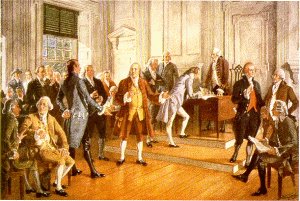In order to form a more perfect Constitution Day picture gallery
 We are now a month away from Constitution Day, an annual source of consternation for educational administrators nationwide. Not to worry. In the immediate wake of its embrace of visual literacy, Jurisdynamics will endeavor to perform a public service by enriching the visual commemoration of Constitution Day.
We are now a month away from Constitution Day, an annual source of consternation for educational administrators nationwide. Not to worry. In the immediate wake of its embrace of visual literacy, Jurisdynamics will endeavor to perform a public service by enriching the visual commemoration of Constitution Day.First, some legal background. Section 111 of the Consolidated Appropriations Act of 2004, Pub. L. No. 108-447, § 111, 118 Stat. 2809, 3344-45 (2004), more colloquially known as the "Constitution Day" statute, states in relevant part:
Each educational institution that receives Federal funds for a fiscal year shall hold an educational program on the United States Constitution on September 17 of such year for the students served by the educational institution.The Department of Education's rule implementing Constitution Day, see Notice of Implementation of Constitution Day and Citizenship Day on September 17 of Each Year, 70 Fed. Reg. 29,727 (May 24, 2005), imposes no specific programming obligation on affected schools, colleges, and universities. Constitution Day, as matters stand, comes dangerously close to being unconstitutional. (Hat tip to my colleague Heidi Kitrosser for having written this snappy little essay.)
The upshot is that the creation and maintenance of websites commemorating the anniversary of the Constitution can help educational institutions comply with the Constitution Day statute. In 2005 the University of Minnesota Law School included the creation of a constitutional law website within its compliance strategy. True to the belief that a picture is worth a thousand words (or more), Minnesota's website included a picture gallery illustrating some leading constitutional controversies.
At this moment, alas, the gallery contains only four images. In an effort to build that gallery, Jurisdynamics now invites its readers -- and in particular law school, college, and high school students -- to submit pictures for display at the Jurisdynamics Network and (subject to institutional constraints beyond my control) at the University of Minnesota's online picture gallery depicting constitutional controversies. Full credit will be given to any person who submits a picture deemed worthy of display. Please submit only images that Jurisdynamics and the University of Minnesota may lawfully display. Please make sure that your pictures are in the public domain or may be displayed under an appropriate license (such as those offered by the Creative Commons). Entries should be submitted by e-mail. Winners will be duly notified. Their schools will also be notified and invited to link to the Jurisdynamics Network's home page and to the University of Minnesota's picture gallery as part of their effort to celebrate Constitution Day.
Constitutional law, of course, is best taught and learned as a series of stories. Therefore, successful entries should include a brief written account describing the picture and its relevance to constitutional law. The existing gallery's page on Roscoe Filburn is indicative of the submission I have in mind. I am reproducing the image and its narrative for the convenience of would-be contestants:

(This photo is reproduced with the kind permission of Mary Lou Spurgeon, daughter of Roscoe Filburn.)Roscoe Filburn, a farmer in Montgomery County, Ohio, planted 23 acres of wheat in fall 1940 and harvested 462 bushels in July 1941. He thereby exceeded his acreage allotment for that planting season under the Agricultural Adjustment Act of 1938. Acting under the 1938 Act, the agricultural conservation committee for Montgomery County assessed a penalty of $0.49 against each of Mr. Filburn's 239 excess bushels. Mr. Filburn challenged the penalty, and the entire Agricultural Adjustment Act, as a violation of the constitutional limits of Congress's power to regulate interstate commerce.
In a landmark decision styled Wickard v. Filburn, 317 U.S. 111 (1942), the Supreme Court rejected Mr. Filburn's challenge and upheld the Agricultural Adjustment Act. Wheat grown on the Filburn farm, though consumed on the premises and never shipped out of state, sufficiently affected the national economy to permit federal regulation of Mr. Filburn's crop and that of millions of other similarly situated farmers. For detailed analysis of the Filburn
decision and its contemporary significance, see Jim Chen, Filburn's
Legacy, 52 Emory L.J. 1719 (2003).












0 Comments:
Post a Comment
<< Home